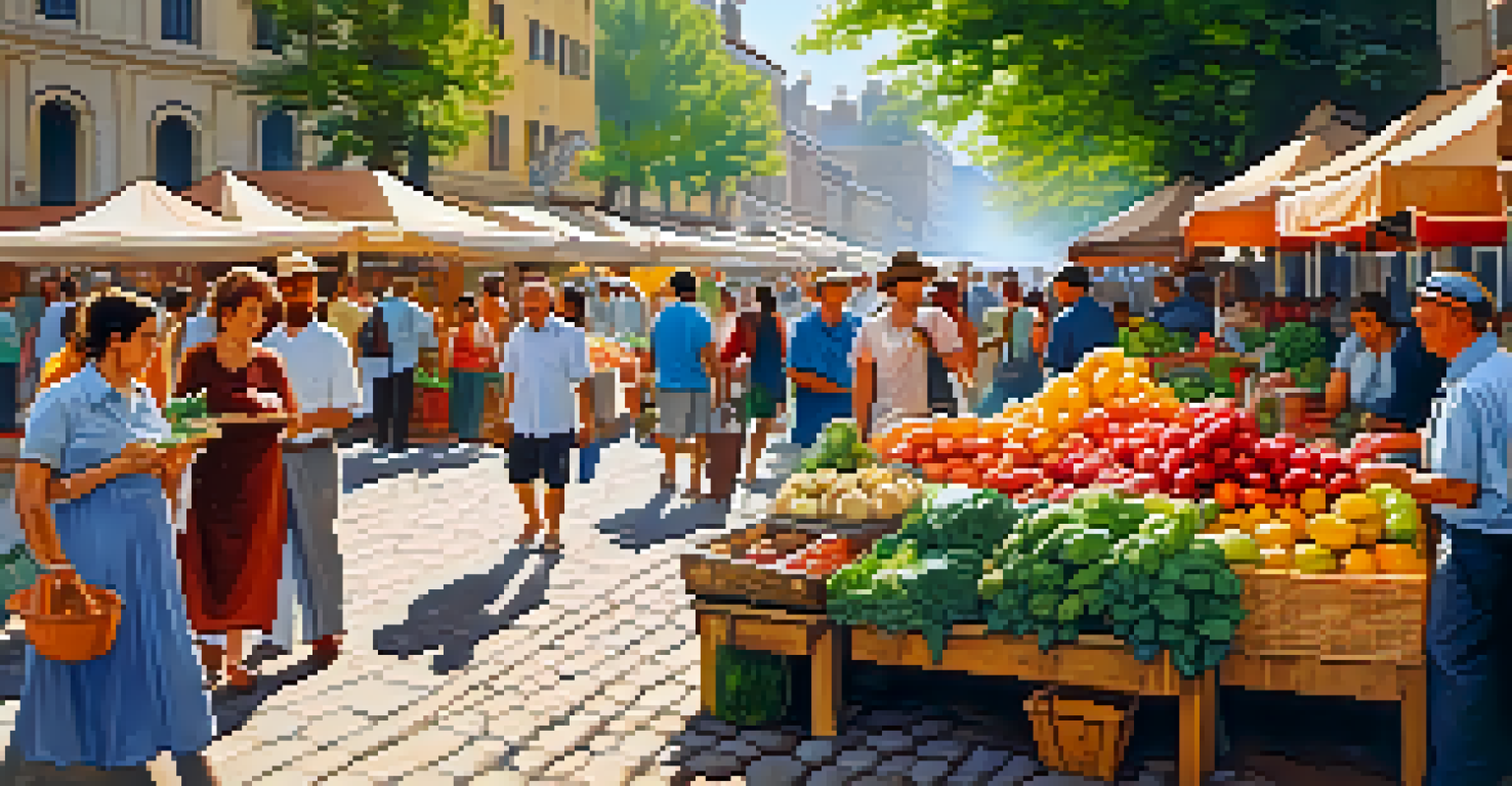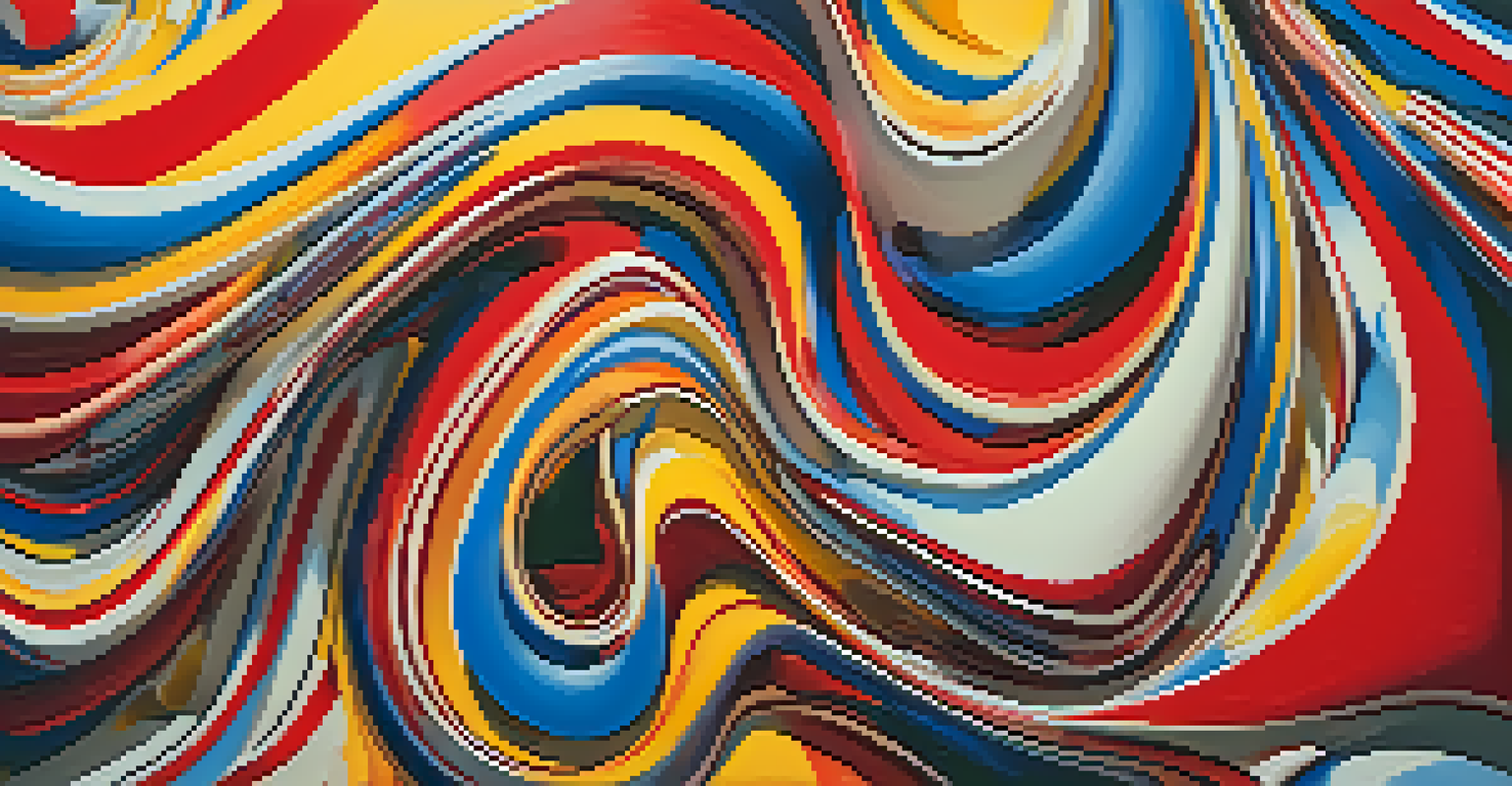Artistic Movements: Reflections of Human Thought and Feeling

The Essence of Artistic Movements in History
Artistic movements are more than just styles; they are reflections of the cultural, social, and political climates of their times. Each movement emerges as a response to the prevailing circumstances, capturing the essence of human thought and feeling. For instance, the Romantic movement arose in reaction to the Industrial Revolution, focusing on emotion and nature over reason and industry.
Every artist dips his brush in his own soul, and paints his own nature into his pictures.
Understanding these movements provides insight into how artists express their experiences and societal commentary through their work. They serve as a mirror to humanity, showcasing our struggles, aspirations, and philosophies. By studying these movements, we gain a deeper appreciation for how art influences and is influenced by the world around us.
Ultimately, artistic movements reveal the interconnectedness of creativity and context, highlighting how artists are not only creators but also commentators on the human condition. This interplay between art and society continues to evolve, making the study of these movements a fascinating journey.
Romanticism: Embracing Emotion and Nature
Romanticism emerged in the late 18th century, emphasizing individual emotion, nature, and the sublime. Artists like Caspar David Friedrich and William Turner explored these themes, showcasing the beauty and power of nature while also delving into deep emotional landscapes. This movement was a reaction against the rationalism of the Enlightenment, prioritizing feelings and personal experiences.

Romantic artists often depicted dramatic scenes that conveyed intense emotions, from passion to melancholy. Their works invite viewers to connect with their own feelings, creating a shared experience that transcends time. For example, Friedrich's painting 'Wanderer above the Sea of Fog' evokes a sense of awe and introspection, encouraging us to reflect on our place in the world.
Art Reflects Society's Pulse
Artistic movements serve as reflections of the cultural, social, and political climates of their times, providing insight into human thought and feeling.
In essence, Romanticism reminds us of the importance of emotion and the natural world in our lives. It encourages a deeper connection to our surroundings and to ourselves, reminding us that art can serve as a powerful conduit for personal and collective reflection.
Impressionism: Capturing Fleeting Moments
Emerging in the late 19th century, Impressionism revolutionized the art world by capturing the transient effects of light and color. Artists like Claude Monet and Edgar Degas sought to portray everyday scenes and fleeting moments, using loose brushwork and vibrant palettes. This movement marked a shift from traditional techniques to a more spontaneous and expressive approach.
Art is the most beautiful of all lies.
Impressionists often painted en plein air, or outdoors, allowing them to capture the essence of a scene as it unfolded. This technique not only emphasized the beauty of everyday life but also highlighted the changing nature of perception. For instance, Monet's series of 'Water Lilies' captures the subtle shifts in light and mood throughout the day, inviting viewers to experience the beauty of the moment.
Through Impressionism, we learn to appreciate the beauty in the ordinary and the importance of seizing the moment. This movement resonates with our desire for connection to the world around us, reminding us that art can encapsulate the fleeting nature of life.
Expressionism: Art as Emotional Outpouring
Expressionism, which gained prominence in the early 20th century, focused on representing emotional experiences rather than physical reality. Artists like Edvard Munch and Wassily Kandinsky used bold colors and distorted forms to convey feelings of anxiety, fear, and exhilaration. This movement sought to express the turmoil of the human psyche in a rapidly changing world.
The iconic painting 'The Scream' by Munch exemplifies the essence of Expressionism, capturing a visceral sense of existential dread that resonates with many. Through such works, Expressionists aimed to evoke strong emotional responses from their audience, inviting them to confront their own feelings and fears.
Emotions Drive Artistic Expression
Movements like Romanticism and Expressionism highlight the importance of emotion in art, encouraging deeper connections to nature and personal experiences.
Ultimately, Expressionism serves as a powerful reminder of art's ability to communicate complex emotions. It encourages viewers to explore their own inner landscapes, acknowledging that vulnerability and emotional depth are integral parts of the human experience.
Cubism: Breaking Down Perceptions of Reality
Cubism, developed by Pablo Picasso and Georges Braque in the early 20th century, challenged traditional representations of form and perspective. By fragmenting subjects into geometric shapes and presenting multiple viewpoints, Cubism redefined how we perceive reality. This movement was revolutionary, inviting viewers to engage with art in a dynamic and interactive way.
Cubism reflects the complexities of modern life, emphasizing that our perception of the world is multifaceted. For instance, Picasso's 'Les Demoiselles d'Avignon' dissects the human figure, offering a raw and honest portrayal that invites contemplation. This approach encourages viewers to question their assumptions about art and reality.
In essence, Cubism teaches us that there is no singular way to experience the world. It challenges us to embrace complexity and ambiguity, fostering a deeper understanding of both art and life.
Surrealism: Dreamscapes and the Unconscious Mind
Surrealism emerged in the 1920s, drawing inspiration from dreams, the subconscious, and the irrational. Artists like Salvador Dalí and René Magritte created fantastical worlds that defy logic, inviting viewers to explore the depths of their imagination. This movement sought to challenge conventional thought and reveal the hidden truths of the human psyche.
For example, Dalí's 'The Persistence of Memory' presents a dreamlike landscape where time appears to melt away, prompting reflection on the nature of reality and perception. Surrealism encourages us to embrace the absurd and question our understanding of existence.
Contemporary Art Challenges Norms
Contemporary art addresses modern issues such as identity and social justice, emphasizing the artist's role as a social commentator and a force for change.
Through Surrealism, we learn that art can serve as a bridge to our innermost thoughts and feelings. It invites exploration of our dreams and fears, revealing the complexities of human experience in a way that is both captivating and thought-provoking.
Contemporary Art: A Reflection of Our Times
Contemporary art encompasses a diverse range of styles and mediums, reflecting the complexities of modern society. Artists today grapple with issues such as identity, technology, and social justice, using their work to comment on the world around them. This movement is characterized by its fluidity and willingness to challenge established norms.
For instance, artists like Ai Weiwei and Banksy use their platforms to address political and social issues, inviting viewers to engage in critical dialogue. Contemporary art often blurs the lines between art and activism, emphasizing the role of the artist as a social commentator.

Ultimately, contemporary art serves as a powerful reflection of our times, capturing the diverse voices and experiences of a global community. It encourages us to consider our place in the world and the impact of our actions, reminding us that art remains a vital force for change.
The Enduring Impact of Artistic Movements
Artistic movements have a profound and lasting impact on culture and society. They not only shape the way we perceive art but also influence our understanding of ourselves and the world. By studying these movements, we can trace the evolution of human thought and feeling across generations.
Moreover, the dialogue between art and society continues to evolve, with each new movement building on the ideas of its predecessors. This interconnectedness highlights the importance of creativity in addressing contemporary issues and expressing collective experiences. The lessons of the past remain relevant, providing insights into our present and future.
In conclusion, artistic movements are essential to understanding the human experience. They serve as a testament to our capacity for creativity and reflection, reminding us that art is a powerful tool for exploring the depths of thought and feeling.